Numerical Study of Heat Transfer and Speed Air Flow on Performance of an Auto-Ventilated Disc Brake
Abstract
1. Introduction
2. Materials and Methods
2.1. Auto-Ventilated Disc Brake
2.2. Disc Brakes Geometry
2.3. Mathematical Calculations
2.4. Computational Fluid Dynamics (CFD Simulation)
2.5. Grid Type
2.5.1. Mesh Independence Study
2.5.2. Independence of Time
3. Results and Discussions
3.1. Mathematical Results of Heat Transfer
3.2. Newton’s Law of Cooling Results
3.3. CFD Results of Temperature and Fluid Speed Behavior
3.4. Proposal for a New Disc Brake Geometry
4. Conclusions
Author Contributions
Funding
Institutional Review Board Statement
Informed Consent Statement
Data Availability Statement
Acknowledgments
Conflicts of Interest
Nomenclature
| Disc brake outer diameter. (m). | |
| Disc brake inner diameter. (m). | |
| Disc brake bell diameter. (m). | |
| Disc thickness. (m). | |
| Bell thickness. (m). | |
| Total energy in the disc brake. (J). | |
| Energy in each disc brake. (J). | |
| Heat generated during braking on the disc. (W/m2). | |
| Total heat loss rate in the disc brake. (W). | |
| Rate of total heat loss in the brake disc bell. (W). | |
| Total heat loss rate at the periphery of the disc brake. (W). | |
| Total heat loss rate by rotating effect of the disc brake. (W). | |
| ΔT | Temperature differential between the disc brake and the environment. (°C). |
| Disc brake energy. (J). | |
| Disc brake mass. (Kg). | |
| CP | Specific heat of the material. (J/Kg × °C). |
| Ti | Instantaneous temperature at all times. (°C). |
| T∞ | Ambient temperature. (33 °C). |
| A | Heat transfer area. (m2). |
| U | Coefficient of surface thermal transmission of the material. (J/s × m2 × °C). |
| g | Acceleration of gravity. (9.81 m/s2). |
| t | Newton cooling time. (s). |
| Nu | Nusselt number. (Dimensionless). |
| K | Thermal conductivity. (w/m× °C). |
| D | Disc brake diameter. (m). |
| υ | Fluid kinematic viscosity. (m2/s). |
| ω | angular speed. (Rad/s). |
| Reynolds number for rotary convection. (Dimensionless). | |
| Disc periphery temperature. (m). |
References
- García-León, R.A.; Flórez-Solano, E.; Acevedo-Peñaloza, C. Análisis Termodinámico en Frenos de Disco; ECOE Ediciones: Bogota, Colombia, 2018. [Google Scholar]
- García-León, R.A.; Flórez-Solano, E.; Suárez-Quiñones, Á. Brake Discs: A Technological Review From Its Analysis and Assessment. Inf. Téc. 2019, 83, 217–234. [Google Scholar] [CrossRef]
- Iteco Ingenieros. El triángulo de la Seguridad en tu vehículo. Available online: https://www.itecoingenieros.com/el-triangulo-de-la-seguridad-en-tu-vehiculo/ (accessed on 10 October 2020).
- Sibuscascoche.com, Qué es el triángulo de seguridad de nuestro coche. Available online: https://www.sibuscascoche.com/noticias/2019/seguridad-vial-triangulos-reflectantes-help-flash/#:~:text=Fue%20ideado%20con%20la%20intenci%C3%B3n,contabilizados%20m%C3%A1s%20atropellos%20y%20colisiones (accessed on 10 October 2020).
- Lorenzo, S.S. Propuesta de Diseño Para Disco de Freno Ventilado; Universidad de Valladolid: Valladolid, Spain, 2018. [Google Scholar]
- Wallis, L.; Leonardi, E.; Milton, B.; Joseph, P. Air flow and heat transfer in ventilated disc brake rotors with diamond and tear-drop pillars. Numer. Heat Transf. Part A Appl. 2002, 41, 643–655. [Google Scholar] [CrossRef]
- McPhee, A.D.; Johnson, D.A. Experimental heat transfer and flow analysis of a vented brake rotor. Int. J. Therm. Sci. 2008, 47, 458–467. [Google Scholar] [CrossRef]
- García-León, R.A.; Rojas, E.P. Analysis of the amount of heat flow between cooling channels in three vented brake discs. Ing. Y Univ. 2017, 21, 71–96. [Google Scholar] [CrossRef]
- Atkins, M.; Kienhofer, F.W.; Lu, T.J.; Kim, T. Local Heat Transfer Distributions within a Rotating Pin-Finned Brake Disk. J. Heat Transf. 2020, 142. [Google Scholar] [CrossRef]
- Park, S.B.; Lee, K.S.; Lee, D.H. An investigation of local heat transfer characteristics in a ventilated disc brake with helically fluted surfaces. J. Mech. Sci. Technol. 2007, 21, 2178–2187. [Google Scholar] [CrossRef]
- Nejat, A.; Aslani, M.; Mirzakhalili, E.; Asl, R.N. Heat Transfer Enhancement in Ventilated Brake Disk Using Double Airfoil Vanes. J. Therm. Sci. Eng. Appl. 2011, 3. [Google Scholar] [CrossRef]
- Duzgun, M. Investigation of thermo-structural behaviors of different ventilation applications on brake discs. J. Mech. Sci. Technol. 2012, 26, 235–240. [Google Scholar] [CrossRef]
- Lee, B.J.; Chung, J.T.; Jung, Y.; Kim, H.; Lee, S.; Kim, H.Y. Numerical Study on Fluid Flow and Heat Transfer Characteristics of a Ventilated Brake Disc Connected to a Wheel; SAE: Warrendale, PA, USA, 2018. [Google Scholar] [CrossRef]
- Belhocine, A.; Afzal, A. FEA Analysis of coupled thermo-mechanical response of grey cast iron material used in brake discs. Rev. Cient. 2019, 3, 280–296. [Google Scholar] [CrossRef]
- Belhocine, A.; Bouchetara, M. Investigation of temperature and thermal stress in ventilated disc brake based on 3D thermomechanical coupling model. Ain Shams Eng. J. 2013, 4, 475–483. [Google Scholar] [CrossRef]
- Jiang, L.; Jiang, Y.; Yu, L.; Yang, H.; Li, Z.; Ding, Y. Thermo-Mechanical Coupling Analyses for Al Alloy Brake Discs with Al(2)O(3)-SiC((3D))/Al Alloy Composite Wear-Resisting Surface Layer for High-Speed Trains. Materials 2019, 12, 3155. [Google Scholar] [CrossRef]
- Topouris, S.; Stamenković, D.; Olphe-Galliard, M.; Popović, V.; Tirovic, M. Heat dissipation from stationary passenger car brake discs. Stroj. Vestn./J. Mech. Eng. 2019, 66, 15–28. [Google Scholar] [CrossRef]
- Lakkam, S.; Suwantaroj, K.; Puangcharoenchai, P.; Mongkonlerdmanee, S.; Koetniyom, S. Study of heat transfer on front-and back-vented brake discs. Songklanakarin J. Sci. Technol. 2013, 35, 671–681. [Google Scholar]
- García-León, R.A. Evaluación del Comportamiento de los Frenos de Disco de Los Vehículos a Partir del Análisis de la Aceleración del Proceso de Corrosión. Licentiate Thesis, Universidad Francisco de Paula Santander Ocaña, Ocaña, Colombia, 2014. [Google Scholar]
- García-León, R.A.; Flórez-Solano, E. Dynamic analysis of three autoventilated disc brakes. Ing. E Investig. 2017, 37. [Google Scholar] [CrossRef]
- García-León, R.A.; Flórez-Solano, E.N. Estudio analitico de la transferencia de calor por convección que afectan a los frenos de disco ventilados. Tecnura 2016, 20, 15–30. [Google Scholar] [CrossRef]
- García-León, R.A.; López, J.E.R.; Quintero-Orozco, A.; Gutiérrez-Paredes, G.J. Análisis del caudal en un disco de freno automotriz con alabes de ventilación tipo NACA66-209, utilizando velocimetría de imagen de partículas. Inf. Tec. 2019, 83, 10–24. [Google Scholar] [CrossRef]
- Rivera-López, J.E.; García-León, R.A.; Quintero-Orozco, A.; Diaz-Torrez, E.J.; Gutiérrez-Paredes, G.J.; Echavez-Diaz, R.; Arévalo-Ruedas, J.H. Thermal and fluid-dynamic analysis of an automotive disc brake with ventilation pillars aerodynamic type. J. Phys. Conf. Ser. 2019, 1386. [Google Scholar] [CrossRef]
- García-León, R.A.; Echavez-Díaz, R.; Flórez-Solano, E. Análisis termodinámico de un disco de freno automotriz con pilares de ventilación tipo NACA 66-209. INGE CUC 2018. [Google Scholar] [CrossRef]
- García-León, R.A.; Acevedo-Peñaloza, C.; Rodríguez-Castilla, M. Análisis del caudal de aire en un disco de freno automotriz con alabes de ventilación tipo N-38. Sci. Tech. 2019, 24, 385–389. [Google Scholar] [CrossRef]
- Hwang, P.; Wu, X.; Jeon, Y. Repeated Brake Temperature Analysis of Ventilated Brake Disc on the Downhill Road; SAE: Warrendale, PA, USA, 2008. [Google Scholar] [CrossRef]
- Volchenko, N.; Volchenko, A.; Volchenko, D.; Poliakov, P.; Malyk, V.; Zhuravlev, D.Y.; Vytvytskyi, V.; Krasin, P. Features of the estimation of the intensity of heat exchange in selfventilated disk-shoe brakes of vehicles. East. Eur. J. Enterp. Technol. 2019, 1, 47–53. [Google Scholar] [CrossRef]
- SN. Descripción y Eficacia del Sistema de Frenado. Available online: http://kashima.campuseina.com/mod/book/view.php?id=7679 (accessed on 20 December 2020).
- Afzal, A.; Mujeebu, M.A. Thermo-Mechanical and Structural Performances of Automobile Disc Brakes: A Review of Numerical and Experimental Studies. Arch. Comput. Methods Eng. 2019, 26, 1489–1513. [Google Scholar] [CrossRef]
- Esqueda, M.A.A.; Madrid, M.M.; López, J.A. El Tratamiento de los Hierros Nodulares en el Mejoramiento de los Materiales en la Industria Automotriz; Instituto Mexicano del Transporte: Pedro Escobedo, Mexico, 2000.
- Ibhadode, A.O.A.; Dagwa, I.M. Development of asbestos-free friction lining material from palm kernel shell. J. Braz. Soc. Mech. Sci. Eng. 2008, 30, 166–173. [Google Scholar] [CrossRef]
- García-León, R.A.; Flórez-Solano, E.; Rodríguez-Castilla, M.M. Thermo-mechanical assessment in three auto-ventilated disc brake by implementing finite elements. J. Phys. Conf. Ser. 2019, 11, 1129. [Google Scholar] [CrossRef]
- Cengel, Y.A.; Boles, M.E. Termodinamica—Cengel 7th; McGraw Hill: Mexico City, Mexico, 2011. [Google Scholar]
- Echavez-Díaz, R.D.; Quintero-Orozco, A. Estudio Experimental del Comportamiento Dinámico del Fluido del Aire a Través de un Disco de Freno Automotriz con Pilares de Ventilación Tipo NACA 66-209. Licentiate Thesis, Universidad Francisco de Paula Santander Ocaña, Ocaña, Colombia, 2017. [Google Scholar]
- García-León, R.A. Thermal study in three vented brake discs, using the finite element analysis. DYNA 2017, 84, 19–27. [Google Scholar] [CrossRef]
- Cengel, Y. Tansferencia de Calor y Masa. Un Enfoque Práctico. Tercera Edición; McGraw-Hil: Mexico City, Mexico, 2007. [Google Scholar]
- Inclopera, F.P.; de Witt, D.P. Fundamentos de Transferencia de Calor; Pearson Educación: London, UK, 1999. [Google Scholar]
- Voller, G.P.; Tirovic, M.; Morris, R.; Gibbens, P. Analysis of automotive disc brake cooling characteristics. Proc. Inst. Mech. Eng. Part D J. Automob. Eng. 2003, 217, 657–666. [Google Scholar] [CrossRef]
- Naga-Vamsi, K.; Thuppal, V.S. Heat Transient Transfer Analysis of Brake Disc/Pad System; Blekinge Institute of Technology: Karlshamn, Sweden, 2016. [Google Scholar]
- Lakkam, S.; Puangcharoenchai, P.; Suwantaroj, K. A study of heat transfer on front and back vented brake disc affecting vibration. Eng. J. 2017, 21, 169–180. [Google Scholar] [CrossRef]
- SolidBI. Solidworks—Qué es y Para Qué Sirve. 2020. Available online: https://solid-bi.es/solidworks/#:~:text=Definición,3Dyplanosen2D.&text=Susproductosofrecenlaposibilidad,datosdelprocesodediseño (accessed on 10 February 2021).
- 3Dcadportal. ANSYS Plataforma de Solucion CAE. 2021. Available online: https://www.3dcadportal.com/ansys.html (accessed on 10 February 2021).
- Sobachkin, A.; Dumnov, G.; Sobachkin, A. Base Numérica de CFD Integrada en CAD. Informe Técnico; SolidWorks: Waltham, MA, USA, 2014. [Google Scholar]
- Thuresson, A. CFD and Design Analysis of Brake Disc; Charlmers University of Tecnology: Göteborg, Sweden, 2014. [Google Scholar]
- Tapia-Martin, E. Capitulo 5. Fluido Computacional (CFD). España. 2020. Available online: http://bibing.us.es/proyectos/abreproy/4882/fichero/Análisis+del+sistema+de+ventilación+de+un+secadero+solar+mediante+tecnica+fluidodinámica+computacional%252FCapitulo+5.+Fluidodinámica+Computacional.pdf (accessed on 10 February 2021).
- Belhocine, A.; Omar, W.Z.W. Computational fluid dynamics (CFD) analysis and numerical aerodynamic investigations of automotive disc brake rotor. Aust. J. Mech. Eng. 2018, 16, 188–205. [Google Scholar] [CrossRef]
- Mazidi, H.; Jalalifar, S.; Jalalifar, S.; Chakhoo, J. Mathematical modeling of heat conduction in a disk brake system during braking. Asian J. Appl. Sci. 2011, 4, 119–136. [Google Scholar] [CrossRef]
- Yevtushenko, A.; Grzes, P. Finite Element Analysis of Heat Partition in a Pad/Disc Brake System. Numer. Heat Transf. Part A Appl. 2011, 59, 521–542. [Google Scholar] [CrossRef]
- Adamowicz, A.; Grzes, P. Influence of convective cooling on a disc brake temperature distribution during repetitive braking. Appl. Therm. Eng. 2011, 31, 2177–2185. [Google Scholar] [CrossRef]
- Talati, F.; Jalalifar, S. Analysis of heat conduction in a disk brake system. Heat Mass Transf. 2009, 45, 1047–1059. [Google Scholar] [CrossRef]
- García-León, R.A.; Acevedo-Peñaloza, C.H.; Rojas-Suarez, J. Análisis Metalográfico y Materiales de Los Frenos de Disco; ECOE: Bogota, Colombia, 2019. [Google Scholar]
- Airfoill Tools. Tools to Search, Compare and Plot Airfoils. 2017. Available online: http://airfoiltools.com/ (accessed on 10 February 2021).
- Jian, Q.; Shui, Y. Numerical and experimental analysis of transient temperature field of ventilated disc brake under the condition of hard braking. Int. J. Therm. Sci. 2017, 122, 115–123. [Google Scholar] [CrossRef]
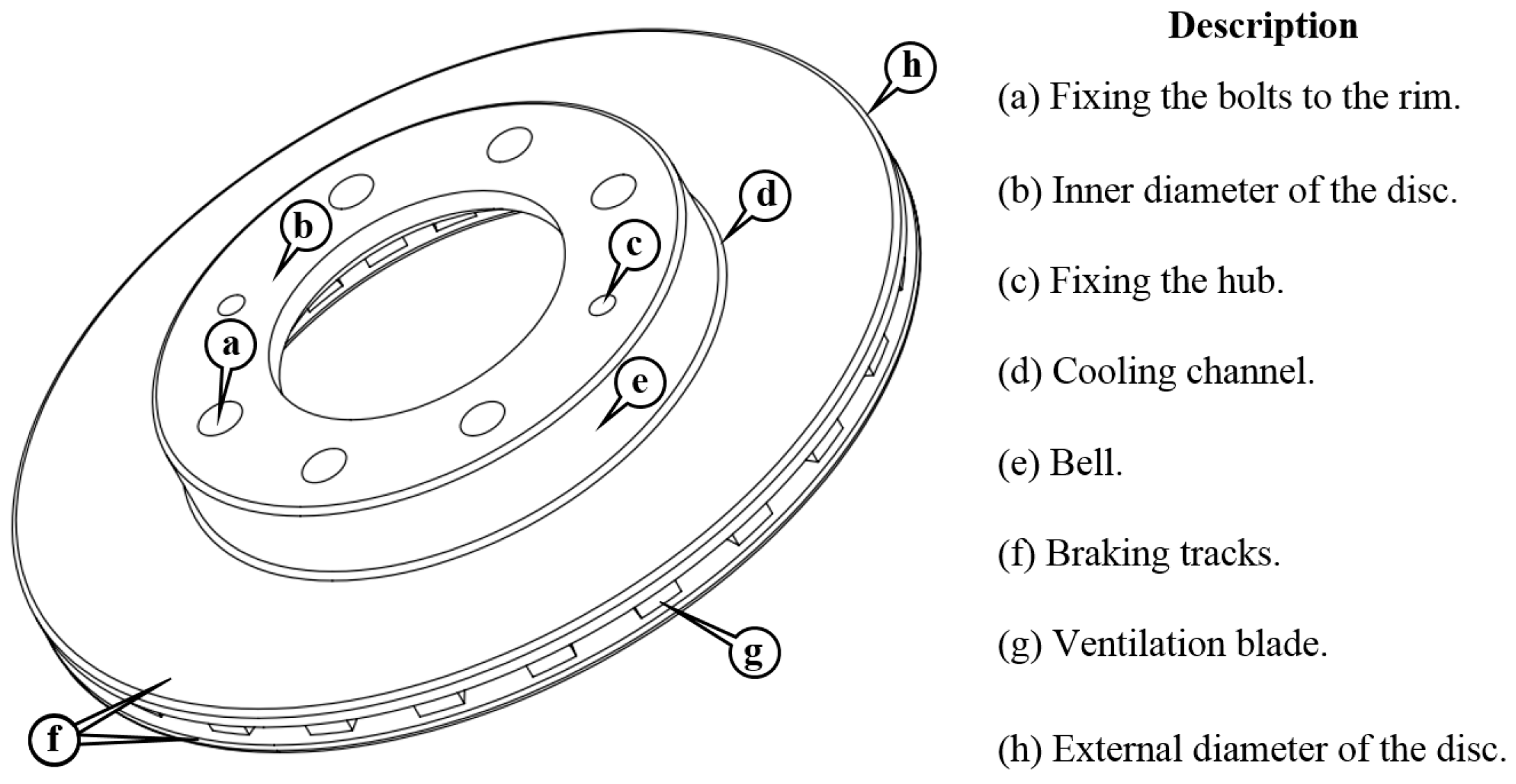


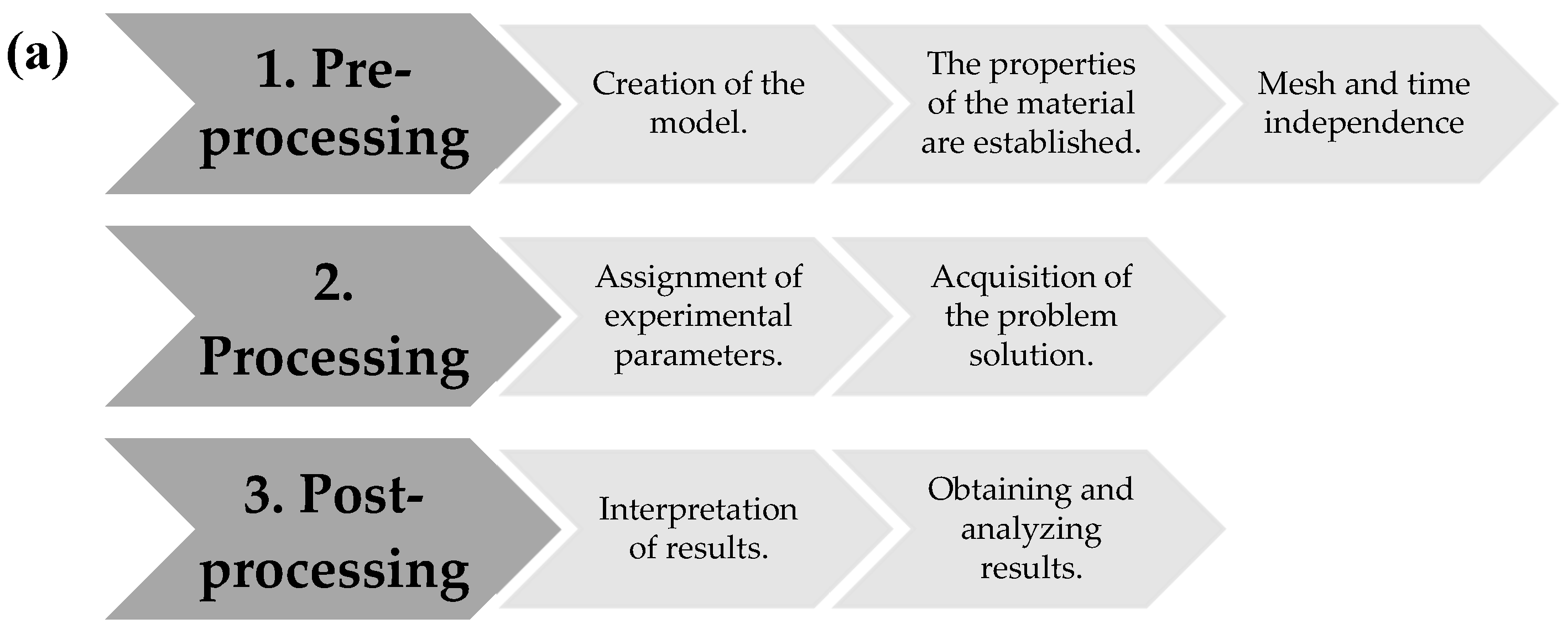

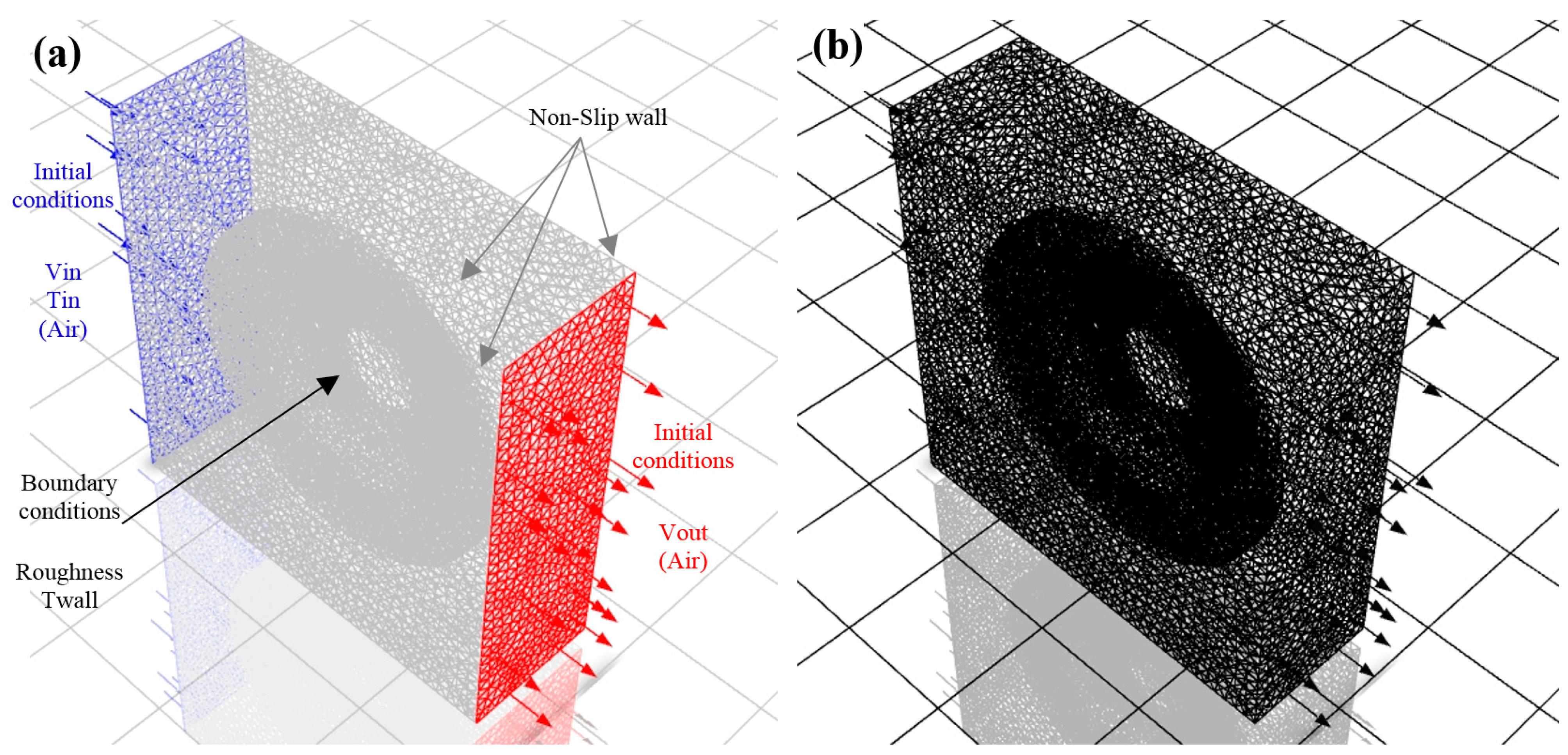


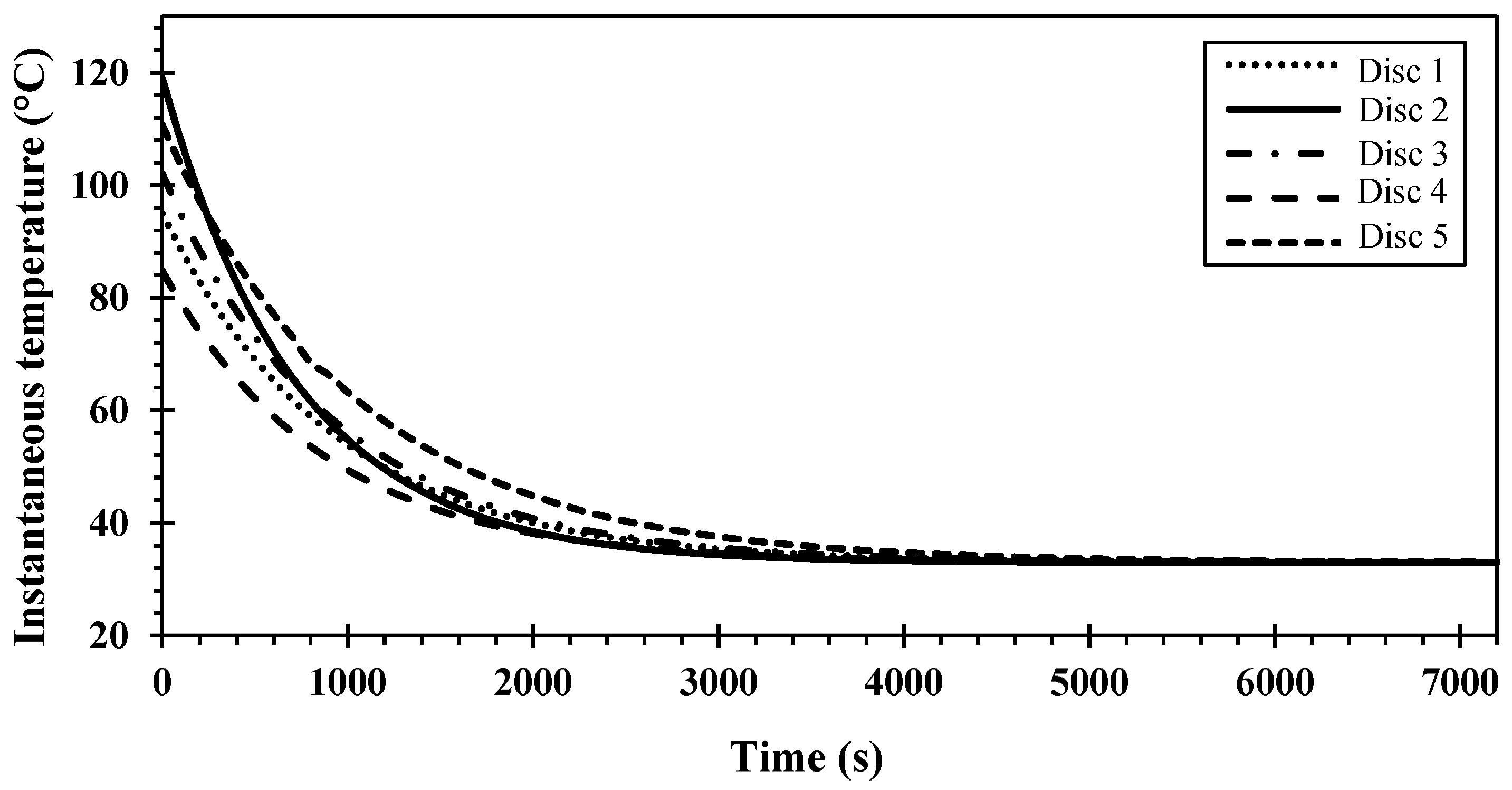
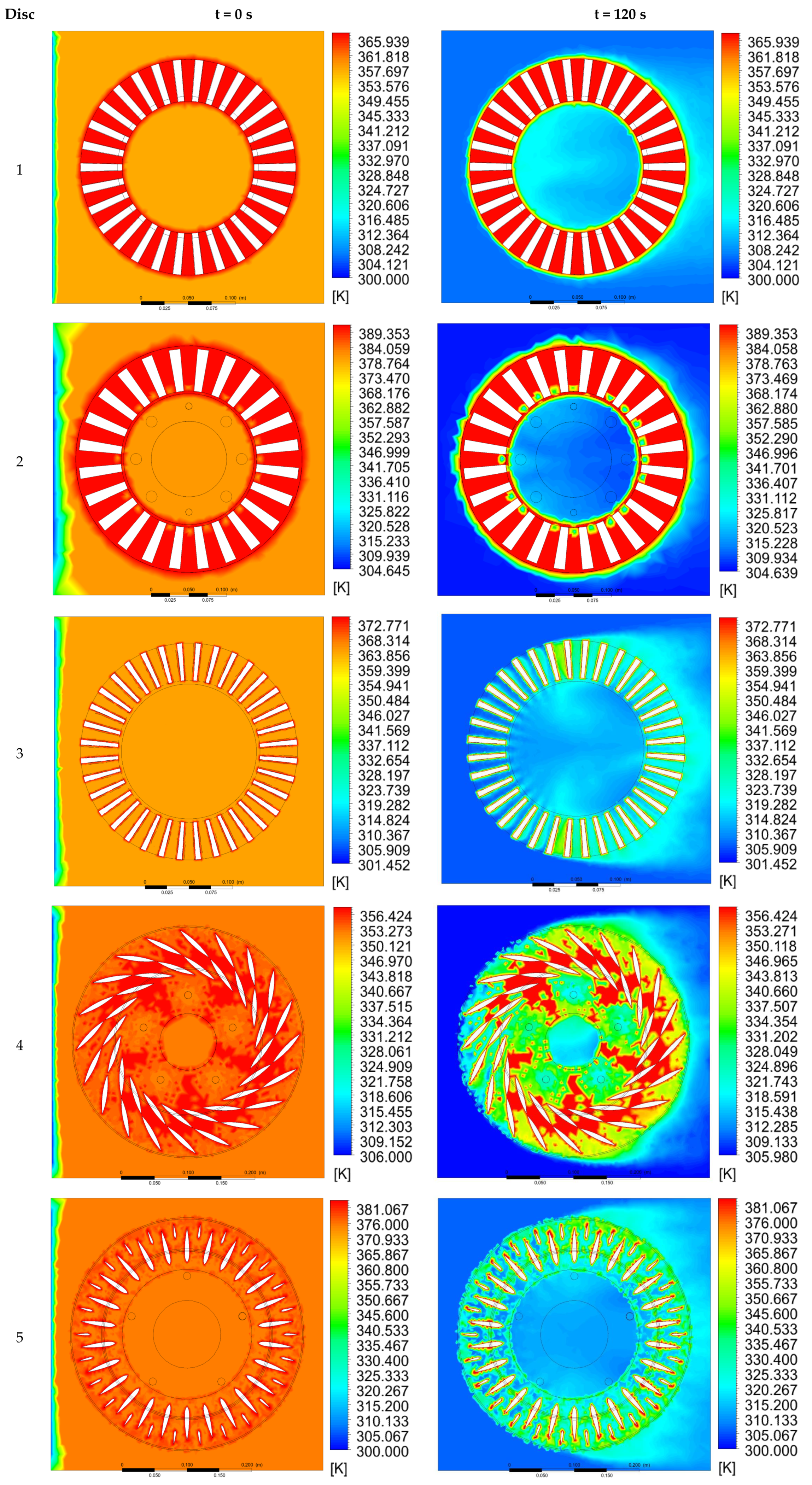
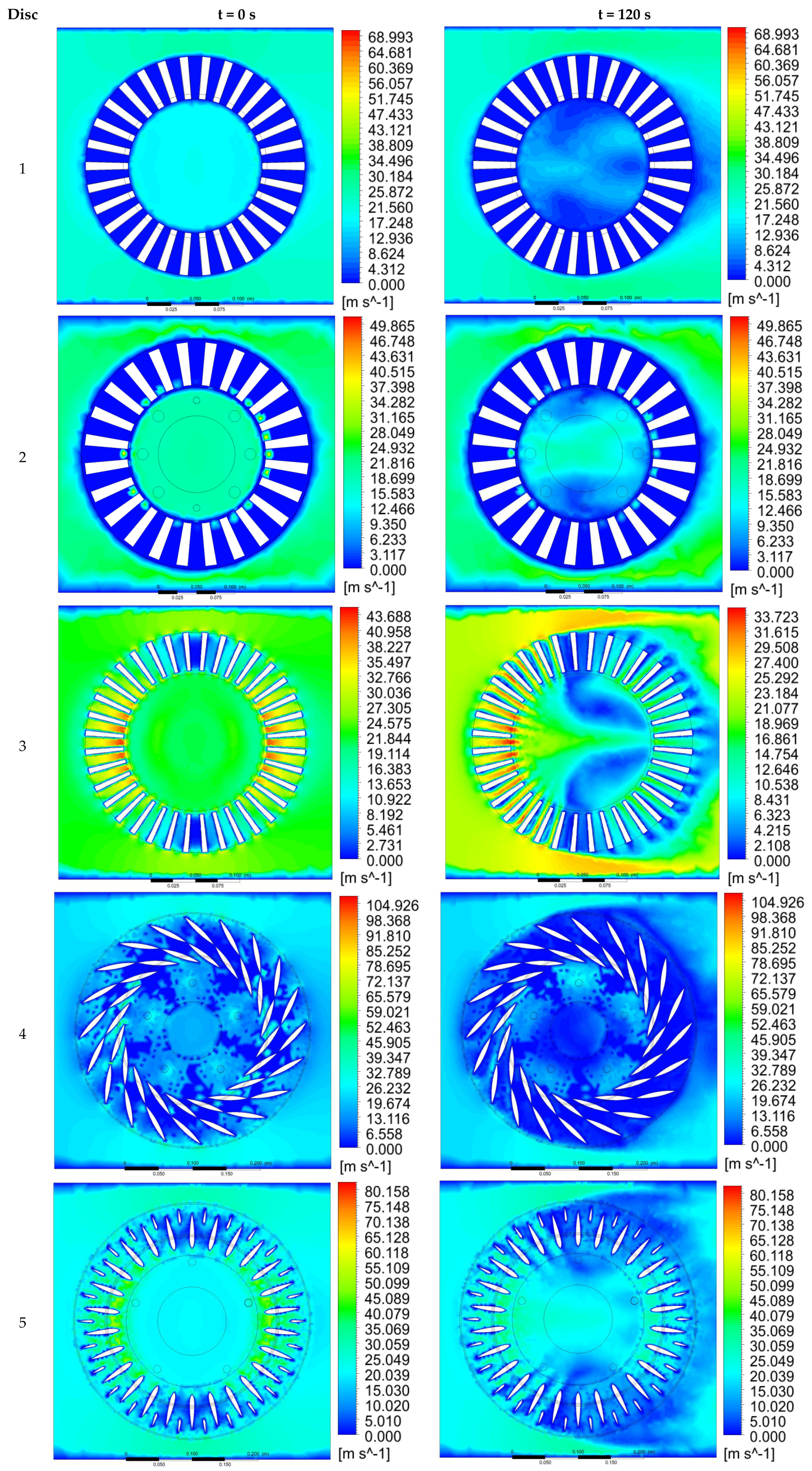
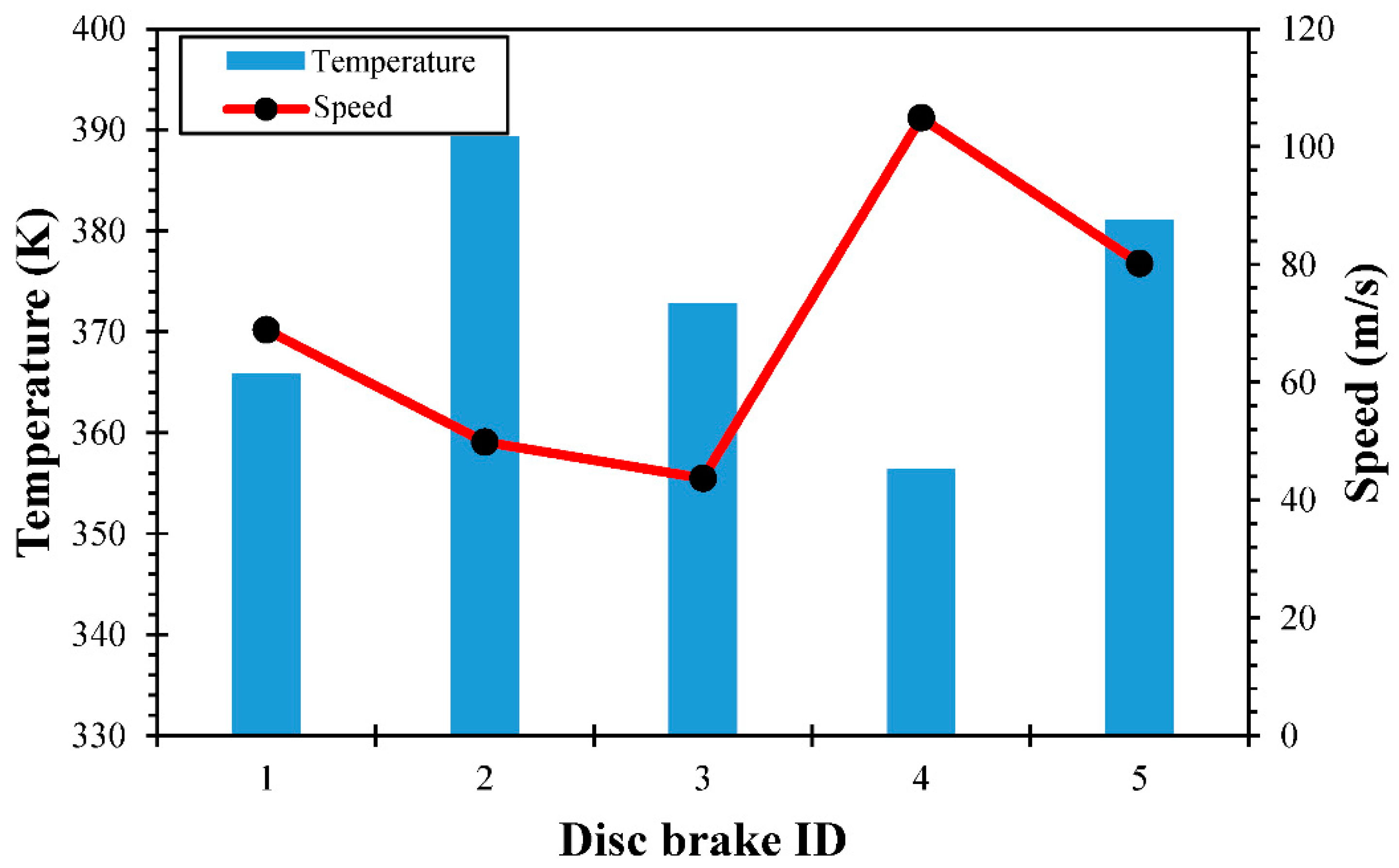

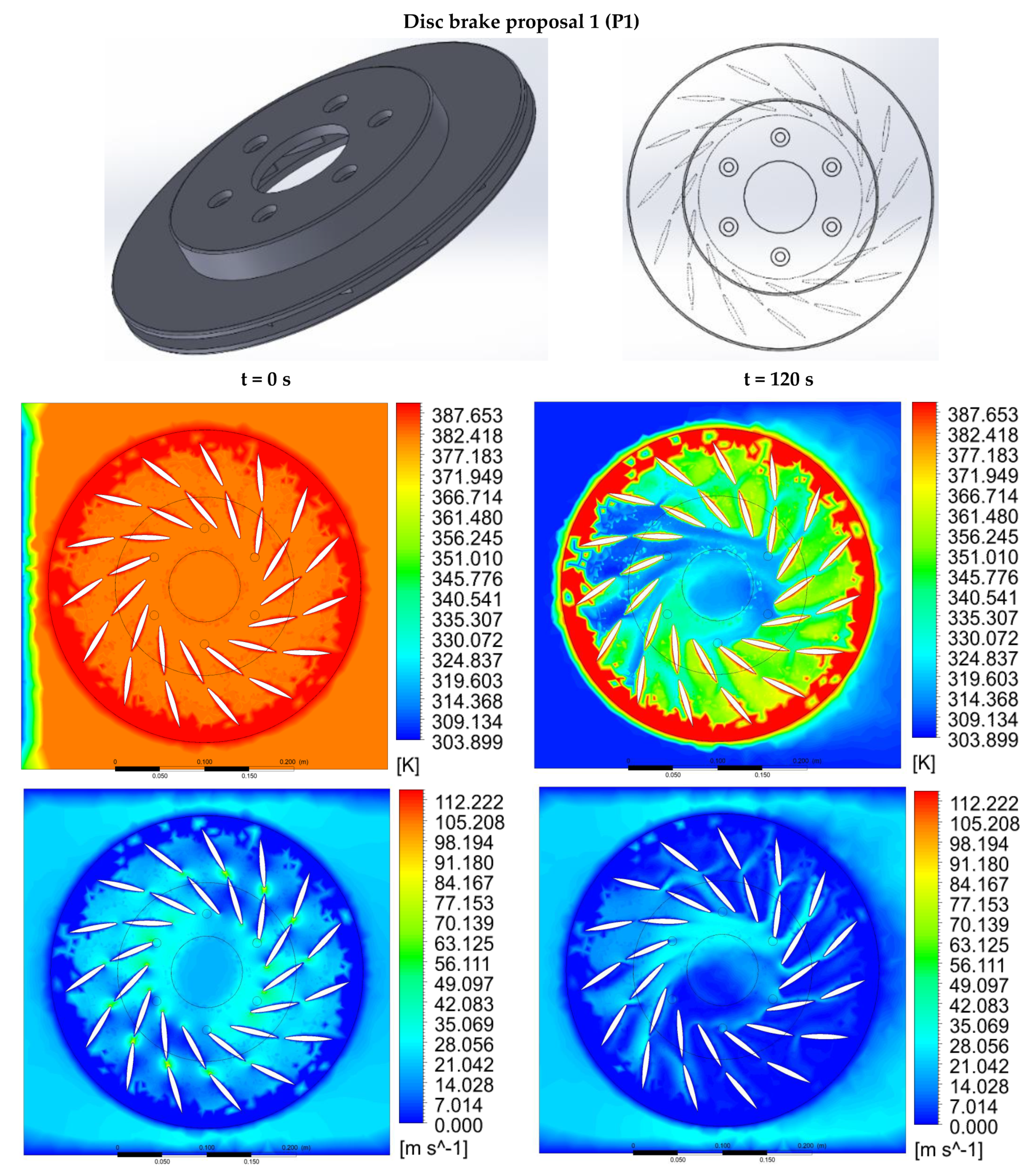
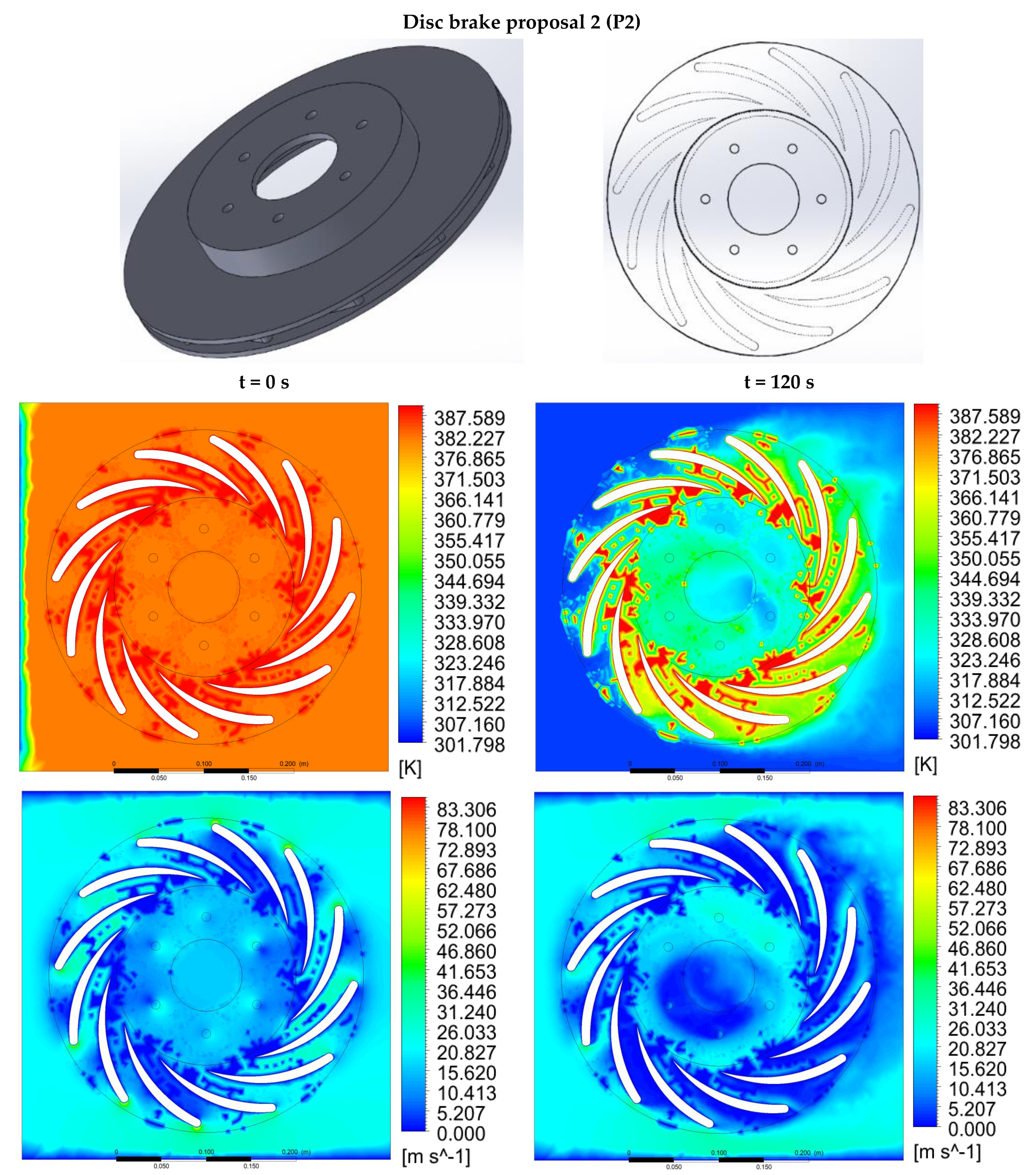
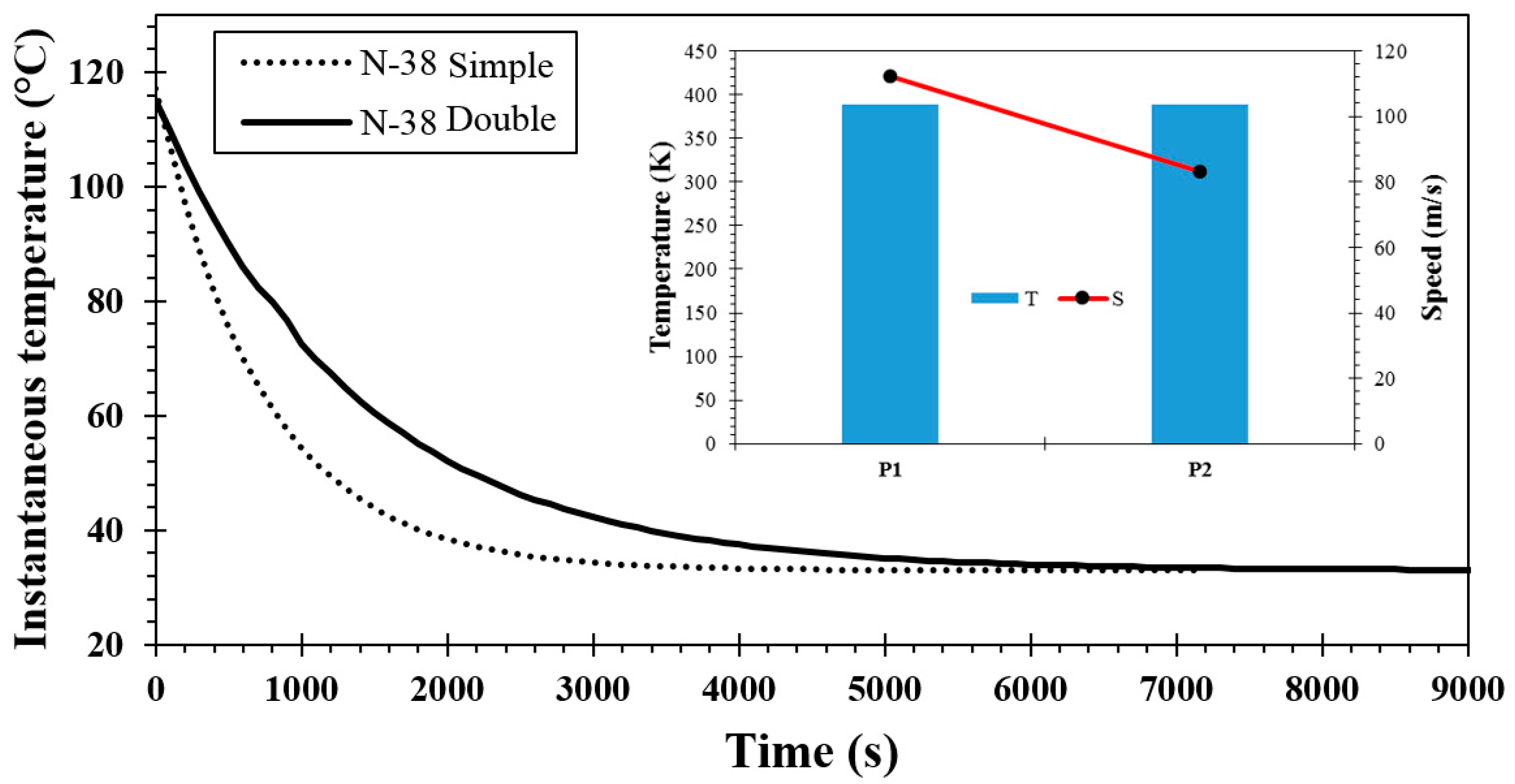
| Property | Symbol | Magnitude |
|---|---|---|
| Brinell hardness | H | 170–250 |
| Shear strength | G | 151 MPa |
| Impact resistance | J | 2.0 J/mm2 |
| Coefficient of friction | µ | 0.30–0.50 |
| Thermal conductivity | k | 41–57 W/m × K |
| Thermic dilatation coefficient | - | 10.5 µm/m between 0–100 °C 13 µm/m between 0–500 °C |
| Melting point | P | 1130–1250 °C |
| Specific heat | Cp | 434–460 J/Kg °C |
| Volumetric mass density | ρ | 7250–8131 Kg/m3 |
| Thermal diffusivity | α | 11.60 × m2/s |
| Thermal transmission coefficient | U | 32 |
| Disc | Isometric View | X-ray View | Specifications |
|---|---|---|---|
| 1 |  | 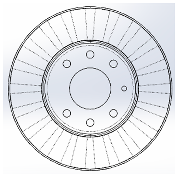 | |
| Rim designation: 195/65/R-15 | |||
| 2 | 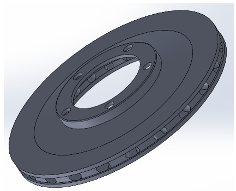 | 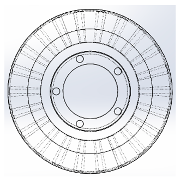 | |
| Rim designation: 205/70/R-15 | |||
| 3 | 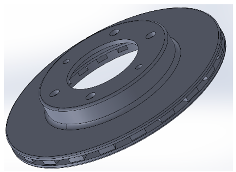 | 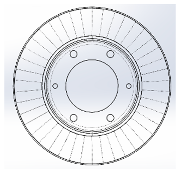 | |
| Rim designation: 275/60/R-18 | |||
| 4 | 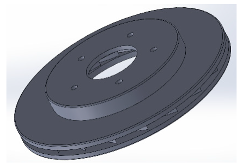 | 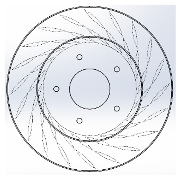 | |
| Rim designation: 275/30/R-19 | |||
| 5 | 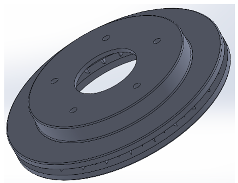 |  | |
| Rim designation: 215/60/R-17 |
| Variable | Disc 1 | Disc 2 | Disc 3 | Disc 4 | Disc 5 |
|---|---|---|---|---|---|
| 102,188.97 | 159,278.04 | 183,879.84 | 158,160.77 | 237,443.24 | |
| 212.89 | 220.84 | 207.88 | 191.48 | 285.14 | |
| 1.5881 | 2.4754 | 2.8577 | 2.4417 | 3.6992 | |
| 94.11 | 132.39 | 174.77 | 159.15 | 229.46 | |
| 1.9204 | 1.6723 | 1.8218 | 3.7197 | 1.1496 | |
| 57.61 | 60.20 | 43.72 | 74.39 | 29.89 | |
| 70 | 66.79 | 57.45 | 68.77 | 102.60 |
| Variable | Disc 1 | Disc 2 | Disc 3 | Disc 4 | Disc 5 |
|---|---|---|---|---|---|
| Ti (°C) | 95 | 119 | 102 | 84.69 | 110.6 |
| Parameters | Disc Brake Proposal 1 | Disc Brake Proposal 2 |
|---|---|---|
| (m) | 0.356 | 0.350 |
| (m) | 0.226 | 0.200 |
| (m) | 0.085 | 0.080 |
| (m) | 0.006 | 0.005 |
| (m) | 0.026 | 0.030 |
| 15 | 12 | |
| Ti (°C) | 117.12 | 115.14 |
| (J) | 143,769.678 | 213,592.385 |
| Q (W/) ×106 | 2.2343 | 3.3194 |
| 1236.74 | 1306.17 | |
| 8.22 | 8.08 | |
| 123.21 | 96.96 |
Publisher’s Note: MDPI stays neutral with regard to jurisdictional claims in published maps and institutional affiliations. |
© 2021 by the authors. Licensee MDPI, Basel, Switzerland. This article is an open access article distributed under the terms and conditions of the Creative Commons Attribution (CC BY) license (https://creativecommons.org/licenses/by/4.0/).
Share and Cite
García-León, R.A.; Afanador-García, N.; Gómez-Camperos, J.A. Numerical Study of Heat Transfer and Speed Air Flow on Performance of an Auto-Ventilated Disc Brake. Fluids 2021, 6, 160. https://doi.org/10.3390/fluids6040160
García-León RA, Afanador-García N, Gómez-Camperos JA. Numerical Study of Heat Transfer and Speed Air Flow on Performance of an Auto-Ventilated Disc Brake. Fluids. 2021; 6(4):160. https://doi.org/10.3390/fluids6040160
Chicago/Turabian StyleGarcía-León, R. A., N. Afanador-García, and J. A. Gómez-Camperos. 2021. "Numerical Study of Heat Transfer and Speed Air Flow on Performance of an Auto-Ventilated Disc Brake" Fluids 6, no. 4: 160. https://doi.org/10.3390/fluids6040160
APA StyleGarcía-León, R. A., Afanador-García, N., & Gómez-Camperos, J. A. (2021). Numerical Study of Heat Transfer and Speed Air Flow on Performance of an Auto-Ventilated Disc Brake. Fluids, 6(4), 160. https://doi.org/10.3390/fluids6040160







